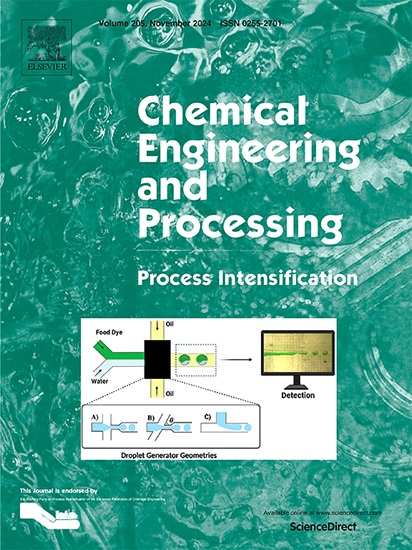Determining residence time distributions in oscillatory baffled reactors: A comparison between experiments and CFD-simulations
IF 3.8
3区 工程技术
Q3 ENERGY & FUELS
Chemical Engineering and Processing - Process Intensification
Pub Date : 2025-04-12
DOI:10.1016/j.cep.2025.110297
引用次数: 0
Abstract
Oscillatory flow reactors are a process intensification technology that aims at enabling plug flow-like operation for inherently slow processes. However, the plug flow regime is usually challenging to obtain in practice. To that end, this work focuses on simulating residence time distributions in oscillatory baffled reactors with for the first time an experimental validation of the simulated results. Four different physical models are implemented to simulate residence time distributions: 2D-axisymmetric laminar, 2D-axisymmetric turbulent -, 3D laminar and 3D turbulent -. Different flow conditions are tested ranging between 50 and 250 for the net Reynolds number and 50 and 300 for the oscillatory Reynolds number. The comparison between experiments and simulations is done qualitatively and quantitatively. The quantitative parameters include: the mean residence time, the root mean square error and the number of ideal tanks in series. The results show that in almost all tested flow conditions 3D laminar physics are necessary to predict the experimental residence time distribution. However, for the tested flow parameters, literature advises in general to use 2D-axisymmetric laminar physics to model local flow patterns. This demonstrates the need for new guidelines to model global parameters in oscillatory baffled reactors and the importance of experimental validation.

振荡折流板反应器停留时间分布的确定:实验与cfd模拟的比较
振荡流反应器是一种过程强化技术,旨在为固有的缓慢过程实现类似塞流的操作。然而,在实践中,通常很难获得塞流分布。为此,本工作着重于模拟振荡折流板反应器中的停留时间分布,并首次对模拟结果进行了实验验证。采用了四种不同的物理模型来模拟停留时间分布:二维轴对称层流、二维轴对称湍流κ-柱、三维层流和三维湍流κ-柱。测试了不同的流动条件,净雷诺数在50到250之间,振荡雷诺数在50到300之间。定性和定量地进行了实验与仿真的比较。定量参数包括:平均停留时间、均方根误差和串联理想槽数。结果表明,在几乎所有的测试流动条件下,三维层流物理都是预测实验停留时间分布的必要条件。然而,对于测试的流动参数,文献一般建议使用二维轴对称层流物理来模拟局部流动模式。这表明需要新的准则来模拟振荡折流板反应器的全局参数,以及实验验证的重要性。
本文章由计算机程序翻译,如有差异,请以英文原文为准。
求助全文
约1分钟内获得全文
求助全文
来源期刊
CiteScore
7.80
自引率
9.30%
发文量
408
审稿时长
49 days
期刊介绍:
Chemical Engineering and Processing: Process Intensification is intended for practicing researchers in industry and academia, working in the field of Process Engineering and related to the subject of Process Intensification.Articles published in the Journal demonstrate how novel discoveries, developments and theories in the field of Process Engineering and in particular Process Intensification may be used for analysis and design of innovative equipment and processing methods with substantially improved sustainability, efficiency and environmental performance.

 求助内容:
求助内容: 应助结果提醒方式:
应助结果提醒方式:


